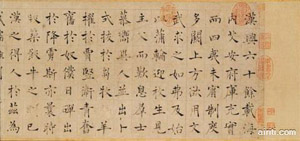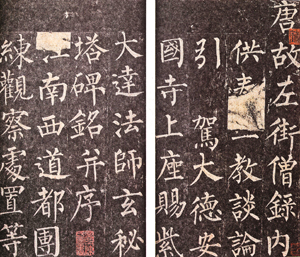Origin and Development of Categories of Calligraphy and Appreciation and Analysis of Calligraphy
Chinese calligraphy consists of five categories of seal script,、clerical script,、cursive script,、running script and regular script.
Regular Script
Regular script is also known as “uniform script” and “real script”, referring to a typeface of order. Regular script is a regular typeface directly evolved from clerical script. It turned the “silkworm head and wild goose tail” of clerical script into a flat and straight form. The word turns from being flat to square and regular. Regular script began to bud in the late Han dynasty, gaining momentum in Wei-Jin North and South dynasties and reaching its prime in the Tang dynasty. This script has remained in use until now and is the fundamental skill people must learn well in their study of calligraphy.
*Selected Works
 |
|
| Eulogy on the Chronicle of Ni Kuan. Chu Suiliang, Tang dynasty |
Chu Suiliang(595-658)together with Ouyang Xun(557-641), Yu Shinan (558-638)and Xu Ji(649-713)are known as the four major masters in the early Tang dynasty. When the development of regular script had reached the stage of the four major masters, the horizontal line appearing flat and the vertical line appearing straight finally was achieved. Also, rules and the format applying to each dot and each line were also set. Therefore, many people believe that authentic regular script did not mature until the Tang dynasty. Chu’s work uses slender and vigorous brushes. Rooms are available in the composition of characters. The strokes are versatile in thickness. Refinements in the movements of pause and tick add to the attraction of Chu’s calligraphy.
The strokes of this piece of calligraphy appear slender and airy. Diversity in the pose of words and changes in the thickness of only one single line convey a sense of self indulgence and the wonder of elegance.
 |
|
| The Mysterious Pagoda Stele. Liu Gongquan, Tang dynasty |
The Reputation of Liu Gongquan’s (778-865) regular script is on par with Yan Zhenqing’s. But Liu’s strokes are less portly than Yan’s as they are slender and rigid and with sharp angles, being orderly configured. Liu said that “a heart of righteousness” is a prerequisite for good calligraphy and Yan is an example. Such an idea shows that the morality of the calligraphers is an influential element in Chinese calligraphic criticism.
Liu’s use of brush and the characters’ composition embody the credentials of the masters of Ouyang Xun, Yu Shinan, Chu Suiliang and Yan Zhenqing, as if offering one conclusion to the order of regular script of the Tang dynasty while establishing its own unique style and school.
The Mysterious Pagoda Stele demonstrates the peculiarity of Liu’s works and the power of control exercised over his characters. The strokes are sharp, beginning with a pressing force, finished in a square-shaped ending. Turning points mostly appear angular. Intensity runs through the whole text without being pressing. The Mysterious Pagoda Stele possesses the features of strength and elegance of Liu, being the model for Liu’s works.




